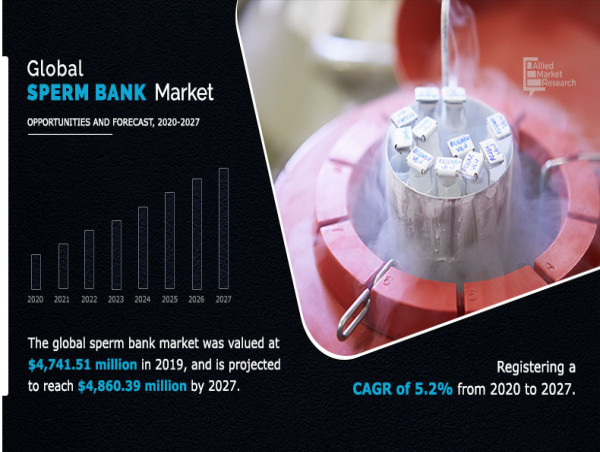PORTLAND, OREGON, UNITED STATES, August 4, 2023/EINPresswire.com/ -- The global sperm bank industry was estimated at $4.74 billion in 2019, and is expected to hit $4.86 billion by 2027, registering a CAGR of 5.2% from 2020 to 2027.
Increasing Acceptance: Sperm donation has become more socially accepted and normalized in recent years. With greater awareness and understanding, more people are opting for donor sperm to fulfill their desire for parenthood. This has expanded the potential customer base for sperm banks.
Technological Advancements: Advances in reproductive technologies have significantly contributed to the growth of the sperm bank market. Techniques such as cryopreservation, sperm washing, and genetic screening have improved the success rates of artificial insemination and in vitro fertilization (IVF) procedures.
Market Competition: The sperm bank industry is becoming more competitive, with both established and new players entering the market. This competition is driving innovation, improved customer service, and efforts to expand donor databases to meet the diverse needs of clients.
Global Market Growth: The sperm bank market is experiencing significant growth globally. This growth is not only seen in developed countries but also in emerging economies where the demand for assisted reproductive technologies is rising. The market is projected to continue expanding in the coming years.
Request Sample Copy of Report: https://www.alliedmarketresearch.com/request-sample/10737
Market Drivers:
Increasing Demand for Assisted Reproductive Technologies: The demand for assisted reproductive technologies (ART) such as artificial insemination and in vitro fertilization (IVF) is on the rise. Factors such as delayed parenthood, infertility issues, and same-sex couples seeking to start a family contribute to this demand. Sperm banks play a crucial role in providing donor sperm for ART procedures, thereby driving the market growth.
Changing Social Trends and Family Structures: Changing social norms and evolving family structures have led to an increased acceptance of alternative methods of family building. This includes single individuals, same-sex couples, and heterosexual couples seeking donor sperm to conceive a child. The growing recognition and acceptance of diverse family arrangements have expanded the customer base for sperm banks.
Market Segmentation:
Service Type:
a. Semen Analysis and Testing: This includes services related to analyzing and testing the quality, quantity, and motility of sperm samples.
b. Sperm Storage and Cryopreservation: This involves the storage and freezing of sperm samples for future use.
c. Donor Sperm: This refers to the supply of donor sperm for individuals or couples seeking fertility treatment.
Donor Type:
a. Anonymous Donor: Donor sperm is provided by individuals who choose to remain anonymous. Identifying information about the donor is typically not disclosed to the recipient.
b. Identity-Release Donor: Donors who agree to release their identity to the offspring when they reach a certain age. This allows the child conceived with the donor sperm to access information about their biological origins.
c. Known Donor: Donor sperm is obtained from someone known to the recipient, such as a family member, friend, or acquaintance.
End User:
a. Fertility Clinics: Sperm banks often collaborate with fertility clinics to provide donor sperm for fertility treatments like artificial insemination and IVF.
b. Individuals or Couples: This includes individuals or couples who directly access sperm bank services for assisted reproduction or family planning purposes.
Geographic Presence:
a. Domestic Market: Sperm banks that primarily cater to the local or national market.
b. International Market: Sperm banks that operate globally or provide services to clients across borders. This may involve shipping donor sperm to different countries.
Price Range:
a. Premium Segment: Sperm banks offering high-quality donor sperm with extensive screening, genetic testing, and detailed donor profiles.
b. Standard Segment: Sperm banks offering standard-quality donor sperm with basic screening and limited donor information.
Additional Services:
a. Genetic Screening: Sperm banks that provide comprehensive genetic testing of donors to identify potential hereditary disorders.
b. Genetic Matching: Sperm banks that offer matching services based on specific genetic traits or characteristics desired by the recipients.
c. Personalized Support: Sperm banks that provide additional support services such as counseling, guidance, and educational resources for individuals or couples.
Procure Complete Report at:
https://www.alliedmarketresearch.com/purchase-enquiry/10737
Regional Growth Dynamics:
Asia-Pacific, followed by Europe and North America generated the major in 2019, holding nearly half of the global sperm bank market, and is expected to dominate by 2027. This region is also projected to cite the fastest CAGR of 5.6% during the forecast period. This is attributed to enormous male populace suffering through infertility and low-cost procedures for fertility treatments in the region.
Competitive Landscape:
California Cryobank
Fairfax Cryobank
Cryos International
European Sperm Bank
Xytex Corporation
Seattle Sperm Bank
New England Cryogenic Center (NECC)
Manhattan Cryobank
London Sperm Bank
Androcryos
Related Reports :
Dental Intraoral Camera Market
Private Nursing Services Market
About Us
Allied Market Research (AMR) is a full-service market research and business-consulting wing of Allied Analytics LLP based in Portland, Oregon. Allied Market Research provides global enterprises as well as medium and small businesses with unmatched quality of "Market Research Reports" and "Business Intelligence Solutions." AMR has a targeted view to provide business insights and consulting to assist its clients to make strategic business decisions and achieve sustainable growth in their respective market domain.
David Correa
Allied Analytics LLP
1 800-792-5285
email us here
Visit us on social media:
Facebook
Twitter
LinkedIn



